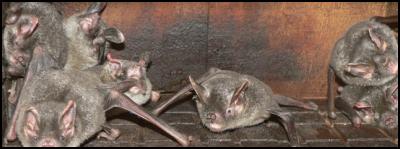Kapiti bats return to captivity
Kapiti bats return to captivity

Click to enlarge
Short-tailed bats in an enclosure on Kapiti Island. Photo: Jacqui McIntosh/DOC
30 November 2006
Kapiti bats return to captivity
An attempt to establish rare short-tailed bats on Kapiti Island has had a set-back following an outbreak of a mysterious ear infection.
The Department of Conservation started the ground-breaking translocation in early 2005, developing techniques to overcome the strong homing instinct of the bats.
Pregnant female bats from a remnant population in the Waiohine Valley, Tararua Forest Park, were taken to the National Wildlife Centre at Pukaha Mount Bruce until they had given birth and weaned their pups. The females were then returned to the wild, and the pups were taken to Kapiti Island and kept in captivity for another couple of months before release.
“Initial results were very encouraging, with most of the transferred bats surviving and staying on Kapiti Island, based on the number of bats returning to accept supplementary food after their release,” DOC technical support manager Colin Miskelly said.
However, late in 2006 the 10 bats known to be free-flying on the island were found to have contracted an ear infection that affected their ability to echo-locate. Exhaustive tests at Massey University veterinary school have so far failed to identify the cause of the infection.
“The department believes that these animals are now unable to survive in the wild, and intends to retain them in captivity to learn more about the affliction and its potential treatment”, Dr Miskelly said.
“Understanding how the condition is transmitted, and whether it can be managed, may be essential for any future bat transfers to Kapiti Island and other sites.”
The department is also investigating what can be done to control potential predators of bats around the surviving population in Tararua Forest Park. These bats will also be surveyed to see whether the ear infection is present in the source population.
ENDS


 Business Canterbury: Urges Council To Cut Costs, Not Ambition For City
Business Canterbury: Urges Council To Cut Costs, Not Ambition For City Wellington Airport: On Track For Net Zero Emissions By 2028
Wellington Airport: On Track For Net Zero Emissions By 2028 Landcare Research: ANZAC Gall Fly Release Promises Natural Solution To Weed Threat
Landcare Research: ANZAC Gall Fly Release Promises Natural Solution To Weed Threat NZ Anti-Vivisection Society: Auckland Rat Lovers Unite!
NZ Anti-Vivisection Society: Auckland Rat Lovers Unite! University of Canterbury: $1.35 Million Grant To Study Lion-like Jumping Spiders
University of Canterbury: $1.35 Million Grant To Study Lion-like Jumping Spiders Federated Farmers: Government Ends War On Farming
Federated Farmers: Government Ends War On Farming



